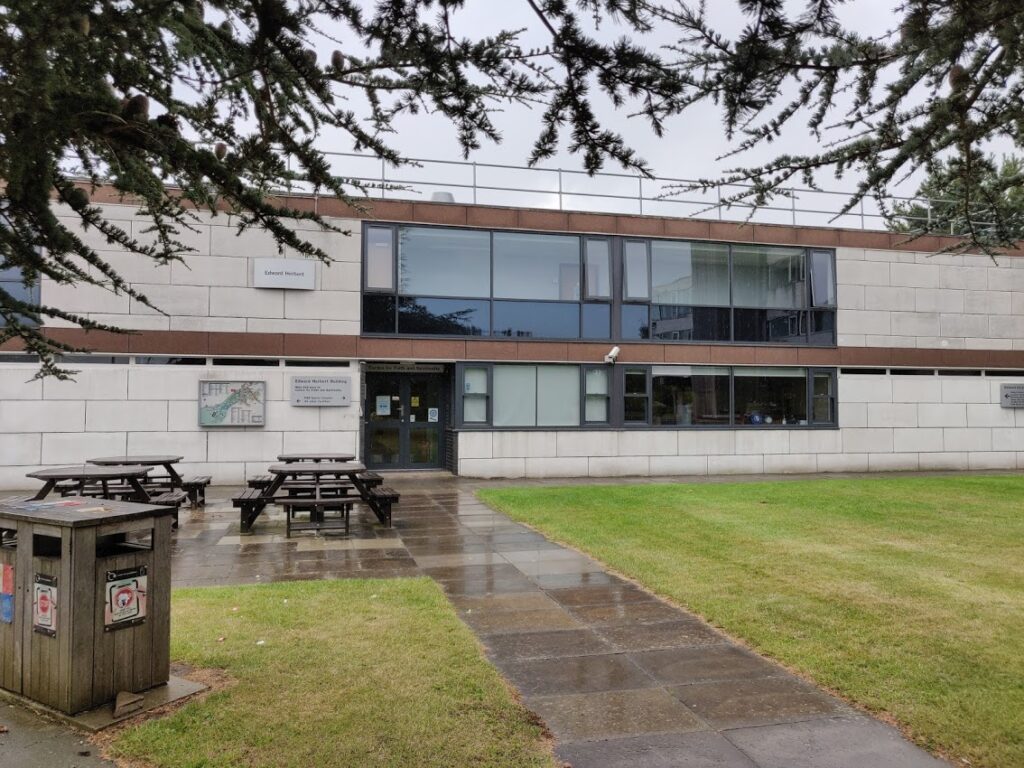Pottering about … Burleigh Hall
15 January 2021
In 1840, T R Potter published a collection of essays entitled ‘Walks Round Loughborough.’ Amongst these was a description of Burleigh Hall. Demolished in 1961, it was replaced by the Edward Herbert Building and part of Administration Building I of Loughborough University. A remnant of the former walled vegetable garden survives adjacent to Administration Building II.


The only nearby reminder of the Hall still standing is the gardener’s cottage, almost hidden from view now, as it probably was to T R Potter. The cottage has many interesting features for us but they were not matters to attract the attention of Potter or his readers.


Originally these essays had been written to occupy one column of a local newspaper. When they appeared in book form he added steel engravings to illustrate some items but sadly Burleigh Hall was not selected.
The walk opens with the approach from Loughborough along the Ashby Road.
| But to our walk. Taking the Ashby-road, the Catholic Chapel will suggest matter for reflection, to Mr Middleton’s Villa and Cottage Ornée will, perhaps agreeably, interrupt it. Burleigh Hall On the left is one of those mansions where the good old times are still fondly cherished. The Hall itself is a pleasing object, and such places are doubly pleasant in the prospect when we know them to be the abode of wisdom and worth. One may speculate on the origin of the name. Has the spot ever been honoured with the presence – or does its possessor claim kindred with – one of the greatest men that ever adorned the tide of times – the great Lord Burleigh? The Hall affords delightful sunset views – equal to any we have seen. The domain, pretty as it is, is sadly disfigured by a thing called a lodge, which abuts on the road, and which is, without exception, the most Finchley-Common looking structure ever erected in such a spot. Our amusement for the next hour must be poking in the hedgerows, where some rare botanical specimens may be gathered. The pedestrian will, however, do well to watch, from time to time, the ever-varying phases of the Forest, not undelighted will he be with such views as will present themselves. When we last took this walk, we had the pleasure of meeting Sir David Wilkie, enjoying con amore scenery, that strongly reminded him of his bonnie native hills. |
The Catholic Chapel is Saint Mary’s which, in 1840, was only what is at the present of the chancel. He mentions the Grove, a house built for the banker and landowner, William Middleton, in a version of the Italianate style. This house still stands but is much adapted to the rear and internally to meet the needs of students of the 20th century. One of cedars planted in the front garden has remained to remind us of the graceful ideas current in the early 19th century. It would be interesting to know the exact location, and whether any of the ‘Cottage Ornée’ survives.
Soon after this Potter mentions, however, that a thing disfigures the domain called a lodge. He also identifies it as the most ‘Finchley-Common’ structure. The lodge stood at the grand entry to Burley Hall. This building survives, hidden by trees and shrubs, and is part of Mumford Hall.
Finchley-Common might have been an allusion to Thackeray’s Vanity Fair where a snob refers to an item written by a washerwoman from Finchley as vulgar and unreadable. Potter implied a vulgar and ugly design.
Burleigh Hall in 1840 had the external characteristics of many classical gentry houses. Its location gave it panoramic views of the eastern style side of Charnwood Forest as well as views towards Garendon Park and across Loughborough to the hills of Cotes. In 1840 the property belonged to Miss Tate, a noted benefactor in Loughborough, whose support for the Public Dispensary (forerunner of the Baxter Gate Hospital) was acknowledged on many occasions.
Perhaps a visitor was Sir David Wilkie R.A., who was a great friend of Sir George Beaumont of Coleorton Hall. Beaumont was a major patron of the arts who contributed to the founding of the National Art Gallery. Perhaps Wilkie may be best known for his rather flattering portrait of King George IV entering Holyrood in full highland dress. However, Wilkie was a favourite artist of George III and William IV. He died in 1841.
Potter’s speculation about the name of the Hall arose from his wish to find a national hero with local associations. In fact, the name means the fortified place on the hill and was in use before Lord Burleigh became Queen Elizabeth I’s advisor.
Most of the Burleigh estate now belongs to the University and it still has some botanical treasures in its grounds.
This article first appeared in the newsletter of Loughborough Archaeological and Historical Society in Spring 2006 under the title ‘Pottering about Loughborough.’
In 1881, the Rev W G Dimock Fletcher wrote about the Burleigh estate in his ‘Historical Handbook to Loughborough.’ Read what he said about it here.
See what Burleigh Park looked like in the early days of the University’s ownership here.
Watch a film of the Leicestershire Yeomanry’s regimental sports event at Burleigh Park in June 1938 here.
Compiled by Alison Mott